Teplice
Teplice (Czech pronunciation: [ˈtɛplɪtsɛ]), Teplice-Šanov until 1948 (Czech pronunciation: [ˈtɛplɪtsɛ ˈʃanof]; German: Teplitz-Schönau), is a statutory city in the Ústí nad Labem Region of the Czech Republic and the capital of the Teplice District. It is Czech Republic's second largest spa town, after Karlovy Vary.
- See other locations named Teplice.
Teplice | |
|---|---|
Castle square and church | |
 Flag  Coat of arms | |
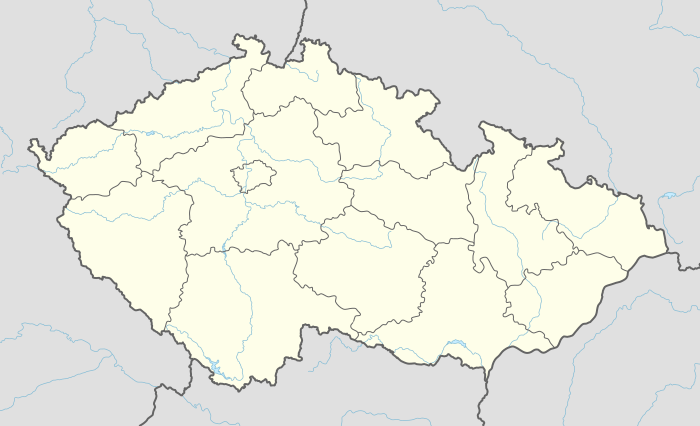 Teplice Location in the Czech Republic | |
| Coordinates: 50°38′N 13°49′E | |
| Country | |
| Region | Ústí nad Labem |
| District | Teplice |
| First mentioned | 12th century |
| Government | |
| • Mayor | Hynek Hanza (ODS) |
| Area | |
| • Total | 23.78 km2 (9.18 sq mi) |
| Elevation | 228 m (748 ft) |
| Population (2020-01-01[1]) | |
| • Total | 49,731 |
| • Density | 2,100/km2 (5,400/sq mi) |
| Time zone | UTC+1 (CET) |
| • Summer (DST) | UTC+2 (CEST) |
| Postal code | 415 01 |
| Website | www.teplice.cz |
Geography
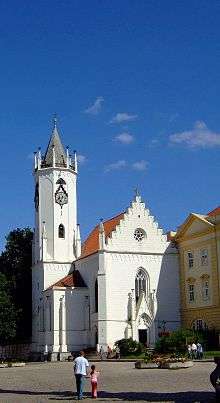
Teplice is located in North Bohemia, near the border with the German state of Saxony. It is situated in the valley of the Bílina river between the slopes of the Ore Mountains (Czech: Krušné Hory) in the northwest and the Central Bohemian Uplands (České středohoří) in the southeast, about 15 km (9.3 mi) west of Ústí nad Labem.
The municipal area comprises the cadastral communities of Teplice proper, Prosetice, Nová Ves, Řetenice, Hudcov, Trnovany, and Sobědruhy.
History
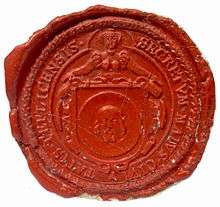
According to the 1541 Annales Bohemorum by chronicler Wenceslaus Hajek, the thermal springs are fabled to have been discovered as early as 762; however, the first authentic mention of the baths occurred in the 16th century. The settlement of Trnovany was first documented in a 1057 deed, while Teplice proper was first mentioned about 1158, when Judith of Thuringia, queen consort of King Vladislaus II of Bohemia, founded a Benedictine nunnery ad aquas calidas ("at the hot springs"), the second in Bohemia. A fortified town arose around the monastery, which was destroyed in the course of the Hussite Wars after the 1426 Battle of Aussig. In the late 15th century, queen consort Joanna of Rožmitál, wife of King George of Poděbrady, had a castle erected on the ruins. The name "Teplice" is derived from the Old Czech, meaning "hot spring".[2]
Teplice figures in the history of the Thirty Years' War, when it was a possession of the Protestant Bohemian noble Vilém Kinský, who was assassinated together with Generalissimo Albrecht von Wallenstein at Cheb in 1634. The Habsburg emperor Ferdinand II thereafter enfeoffed castle and town to his general Johann von Aldringen, who nevertheless was killed in battle in the same year, and Teplice fell to his sister Anna Maria von Clary-Aldringen. Consequently, and until 1945, Teplitz Castle was the primarily seat of the princely House of Clary-Aldringen. After the Thirty Years' War, the devastated town was the destination of many German settlers.
After a blaze in 1793, large parts of the town were rebuilt in a Neoclassical style. The health resort was a popular venue for wealthy bourgeois like the poet Johann Gottfried Seume, who died on his stay in 1810, or Ludwig van Beethoven, who met here with Johann Wolfgang von Goethe in 1812; as well as for European monarchs. During the Napoleonic War of the Sixth Coalition, Teplice in August 1813 was the site where Emperor Francis I of Austria, Emperor Alexander I of Russia and King Frederick William III of Prussia first signed the triple alliance against Napoleon I of France that led to the coalition victory at the nearby Battle of Kulm.
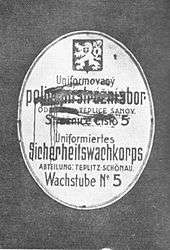
In 1895, Teplice merged with neighbouring Lázně Šanov (Schönau). Upon the dissolution of Austria-Hungary after World War I and the 1919 Treaty of Saint-Germain-en-Laye, the predominantly German-speaking population found itself in newly established Czechoslovakia. Right-wing political groups like the German National Socialist Worker's Party referred to themselves as Volksdeutsche and began to urge for a unification with Germany, their efforts laid the foundation for the rise of the Sudeten German Party under Konrad Henlein after 1933. With the Sudetenland, Teplice was annexed by Nazi Germany according to the 1938 Munich Agreement and incorporated into Reichsgau Sudetenland. In 1930, 3,213 Jews lived in Teplice, 10% of the population. Under the Nazi regime they faced the Holocaust in the Sudetenland. Many fled and the Teplice Synagogue was burnt during Kristallnacht.[3][4]
After World War II the Czechoslovak government enacted the Beneš decrees, whereafter the German-speaking majority of the population was expelled from Teplice. In 1945, the Princes of Clary-Aldringen, lords of Teplice since 1634, were expropriated.
In 1994, Jaroslav Kubera of the Civic Democratic Party (ODS) became mayor of Teplice and he held the position until 2018.
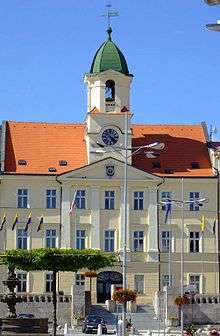
_Teplick%C3%BD_z%C3%A1mek_-_Teplice_517-14_B.jpg)
Sports
Teplice is home to the professional football club FK Teplice playing in the Czech First League. Notable players of the club include Josef Masopust and Pavel Verbíř. The stadium, Na Stínadlech, is one of the largest in the country and has hosted international matches.
Paleontology
Fossils of an elasmosaurid plesiosaur (large carnivorous marine reptile from the Cretaceous period) were found near Teplice at the end of the 19th Century. In Hudcov, a nearby village, plesiosaur Cimoliasaurus teplicensis was described in 1906 by Czech paleontologist Antonín Frič.[5]
Notable people
Natives
- Julius von Payer (1841–1915), arctic explorer
- August Stradal (1860–1930), pianist
- Karl Pohlig (1864–1928), conductor
- Prince Siegfried von Clary-Aldringen (1848–1920), Austro-Hungarian diplomat and nobleman
- Humbert Achamer-Pifrader (1900–1945), SS Colonel
- Paul Kohner (1902–1988), film producer
- Frederick Kohner (1905–1986), writer (Gidget)
- Marianne Winder (1918–2001), librarian
- Helmut Pfleger (born 1943), chess Grandmaster
- Jaromír Kohlíček (born 1953), politician
- Daniela Peštová (born 1970), model
- Robert Lang (born 1970), ice hockey player
- Lucie Králová (born 1982), Miss Czech Republic 2005
Residents
- The mathematician Adam Adamandy Kochański died in Teplice in 1700
- Romantic poet, philosopher, and author Novalis wrote his "Teplitz Fragments" while staying in Teplice[6]
- Poet Johann Gottfried Seume died in Teplice in 1810
- Composer Ludwig van Beethoven began writing his Symphony No. 7 in 1812 while staying in Teplice
- Austrian diplomat and statesman Count Charles-Louis de Ficquelmont (1777–1857), resided at his daughter's castle in Teplice
- Countess Dorothea de Ficquelmont (1804–1863), spouse of the previous, died at her daughter's castle in Teplice
- Richard Wagner began composing the music to his opera Tannhäuser during a vacation in Teplitz in the summer of 1843.
- Austro-Hungarian statesman Count Manfred von Clary-Aldringen (1852–1928), grandson of the previous ones, resided in his family's castle in Teplice
- Oscar Straus worked as a Kapellmeister in Teplice
- Kurt Eichhorn worked as a conductor in Teplice
- The astronomer Otto Tetens died in Teplice in 1945
- The writer Ruth von Mayenburg (1907–1993) grew up in the town
- Adolf Kurrein rabbi (from 1888) and Zionist activist
Climate
| Climate data for Teplice, Czech Republic | |||||||||||||
|---|---|---|---|---|---|---|---|---|---|---|---|---|---|
| Month | Jan | Feb | Mar | Apr | May | Jun | Jul | Aug | Sep | Oct | Nov | Dec | Year |
| Record high °F (°C) | 59 (15) |
67 (19) |
72 (22) |
82 (28) |
91 (33) |
97 (36) |
99 (37) |
101 (38) |
94 (34) |
85 (29) |
67 (19) |
62 (17) |
101 (38) |
| Average high °F (°C) | 35 (2) |
37 (3) |
46 (8) |
56 (13) |
64 (18) |
72 (22) |
76 (24) |
76 (24) |
67 (19) |
55 (13) |
44 (7) |
36 (2) |
55 (13) |
| Daily mean °F (°C) | 29.7 (−1.3) |
31.2 (−0.4) |
38.7 (3.7) |
46.6 (8.1) |
54.2 (12.3) |
62.2 (16.8) |
66.1 (18.9) |
65.9 (18.8) |
57.7 (14.3) |
48.1 (8.9) |
39.7 (4.3) |
32.0 (0.0) |
47.4 (8.6) |
| Average low °F (°C) | 25 (−4) |
25 (−4) |
31 (−1) |
37 (3) |
45 (7) |
52 (11) |
56 (13) |
56 (13) |
48 (9) |
41 (5) |
34 (1) |
28 (−2) |
39.7 (4.3) |
| Record low °F (°C) | −11 (−24) |
−15 (−26) |
1 (−17) |
14 (−10) |
26 (−3) |
37 (3) |
44 (7) |
39 (4) |
34 (1) |
17 (−8) |
10 (−12) |
1 (−17) |
−15 (−26) |
| Average precipitation inches (mm) | 0.98 (25) |
0.98 (25) |
1.26 (32) |
1.61 (41) |
3.03 (77) |
2.95 (75) |
2.75 (70) |
2.81 (71) |
1.65 (42) |
1.22 (31) |
1.26 (32) |
1.22 (31) |
21.72 (552) |
| Source: [7] | |||||||||||||
References
- "Population of Municipalities – 1 January 2020". Czech Statistical Office. 2020-04-30.
- Lutterer, Ivan; Majtán, Ivan; Šrámek, Rudolf (1982). Zeměpisná jména Československa. Slovník vybraných zeměpisných jmen s výkladem jejich původu a historického vývoje. Prague: Mladá Fronta. pp. 301–302.
- Osterloh, Jörg (2015). "Sudetenland". In Gruner, Wolf; Osterloh, Jörg (eds.). The Greater German Reich and the Jews: Nazi Persecution Policies in the Annexed Territories 1935–1945. War and Genocide. Translated by Heise, Bernard. New York: Berghahn Books. pp. 68–98. ISBN 978-1-78238-444-1.CS1 maint: ref=harv (link)
- Kocourek, Ludomír (1997). "Das Schicksal der Juden im Sudetengau im Licht der erhaltenen Quellen" [The Fate of the Jews in Sudetengau in Light of the Surviving Sources]. Theresienstädter Studien und Dokumente (in German) (4): 86–104. CEEOL 155844.CS1 maint: ref=harv (link)
- http://www.osel.cz/11084-skutecna-ceska-lochneska.html
- Novalis: Philosophical Writings
- The Weather Channel
External links
| Wikimedia Commons has media related to Teplice. |